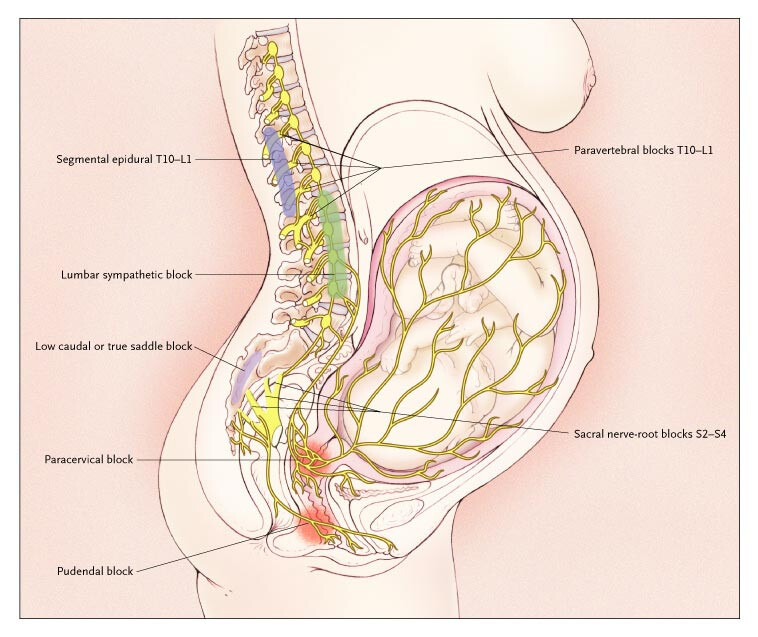Effective pain management during labor is crucial for maternal satisfaction and favorable outcomes. Regional anesthesia, primarily epidural, spinal, or combined spinal-epidural (CSE) techniques, has become the gold standard for labor analgesia. These techniques provide targeted, reversible nerve blockade that allows mothers to remain awake, participate actively in childbirth, and experience significant pain relief.

Types of Regional Anesthesia for Labor Pain
Epidural Anesthesia for Labor
Epidural anesthesia involves administering local anesthetics and adjunct medications into the epidural space through a catheter, offering continuous or intermittent pain relief throughout labor.
Advantages:
- Adjustable and sustained analgesia
- Ability to modify dose and concentration
- Minimal motor block with low-concentration solutions
Procedure Highlights:
- Placement at lumbar interspace (usually L3-L4)
- Test dose to confirm correct catheter placement
- Maintenance with infusion pumps or manual boluses
Spinal Anesthesia for Labor
Spinal anesthesia delivers a single, small dose of anesthetic directly into the cerebrospinal fluid. It is less common for routine labor analgesia but often utilized for rapid, short-duration pain relief, such as for urgent operative deliveries.
Advantages:
- Immediate onset of analgesia
- High efficacy with minimal drug volume
Limitations:
- Fixed duration without catheter placement
- Limited titration once administered
Combined Spinal-Epidural (CSE) Technique
CSE combines the rapid onset of spinal anesthesia with the flexibility of an epidural catheter, making it an ideal choice for unpredictable labor durations.
Advantages:
- Immediate and profound analgesia
- Extended pain control through epidural catheter
- Reduced local anesthetic requirement
Pharmacologic Agents Used in Regional Anesthesia for Labor
Local Anesthetics
- Bupivacaine: Most common agent due to long duration and minimal motor block at low concentrations.
- Ropivacaine: Similar efficacy with even lower motor blockade tendencies.
- Lidocaine: Shorter-acting, primarily used for urgent interventions.
Adjuncts
- Opioids: Fentanyl and sufentanil are often added to enhance analgesia while reducing local anesthetic dosage.
- Epinephrine: Occasionally used to prolong duration by vasoconstriction.
- Clonidine and Neostigmine: Investigational agents that may enhance analgesic effects.
Best Practices for Administering Regional Anesthesia in Labor
Epidural Placement Technique
- Patient Positioning: Sitting or lateral decubitus with spine flexion
- Aseptic Technique: Strict adherence to sterile preparation
- Needle and Catheter Insertion: Midline approach with loss-of-resistance to saline or air
- Confirmation: Careful aspiration and test dosing to prevent intrathecal or intravascular injection
Maintenance of Labor Analgesia
- Continuous Epidural Infusion (CEI): Steady delivery of dilute anesthetic solution
- Patient-Controlled Epidural Analgesia (PCEA): Enhances maternal autonomy, reduces anesthetic consumption, and improves satisfaction
Benefits of Regional Anesthesia for Labor Pain
- Superior Pain Relief: High-quality, segmental sensory blockade with minimal systemic side effects
- Maternal Awareness and Participation: Enables active involvement in the birthing process
- Flexible Dosing: Tailored to labor progression and maternal needs
- Facilitated Conversion to Surgical Anesthesia: In cases requiring cesarean section
Potential Risks and Management Strategies
Hypotension
- Common after neuraxial blockade
- Prevented with preloading fluids and managed with vasopressors like phenylephrine
Motor Blockade
- Reduced with dilute local anesthetic solutions
- Ensures mobility in walking epidural protocols
Post-Dural Puncture Headache (PDPH)
- Rare complication primarily associated with unintentional dural puncture
- Managed with hydration, caffeine, and epidural blood patch if needed
Inadequate Analgesia
- May require catheter adjustment or re-siting
- Dose modification based on labor stage
Special Considerations for Regional Anesthesia in Labor
High-Risk Pregnancies
- Early epidural placement is advised in conditions such as preeclampsia or cardiac disease to ensure immediate access to anesthesia if surgical intervention becomes necessary.
Obesity
- Increased technical difficulty necessitates pre-procedure planning
- Use of ultrasound guidance improves success rates
Coagulopathy
- Absolute contraindication to neuraxial blockade if significant
- Careful evaluation of platelet count and coagulation profile essential
Regional Anesthesia Versus Other Pain Management Options
| Method | Pain Relief Quality | Invasiveness | Maternal Mobility | Common Use |
|---|---|---|---|---|
| Regional Anesthesia | Excellent | Moderate | Variable | Very High |
| Systemic Opioids | Moderate | Low | High | Moderate |
| Nitrous Oxide (Laughing Gas) | Mild | Very Low | High | Low |
| Non-Pharmacologic Methods | Mild to Moderate | None | High | Variable |
Innovations and Future Trends in Regional Anesthesia for Labor
Programmed Intermittent Epidural Bolus (PIEB)
Studies suggest that PIEB provides better analgesia, lower drug consumption, and higher maternal satisfaction compared to continuous infusion techniques.
Ultrasound-Guided Neuraxial Techniques
Real-time imaging enhances success rates, particularly in patients with challenging anatomy.
New Drug Formulations
Liposomal bupivacaine and other slow-release formulations are under investigation to extend analgesic duration and reduce dosing frequency.
Regional anesthesia stands as the cornerstone of effective labor pain management, offering unparalleled pain relief while preserving maternal consciousness and participation. By mastering epidural, spinal, and CSE techniques, optimizing drug regimens, and staying attuned to individual patient needs, we ensure the highest standards of obstetric care. Future innovations promise to further refine and enhance maternal experiences during labor and delivery.

